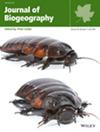Evolution of the Geographic Range of a European Montane Leaf Beetle in Response to Climate Changes at the End of the Quaternary
Abstract
Aim
During the past few 100,000 years, repeated cycles of glaciation and warming episodes have radically altered the range of organisms. Numerous phylogeographic studies have investigated the impact of past climate changes on the range of temperate organisms in Europe, but we know substantially less about organisms that are adapted to colder climates. Their distributions are often currently fragmented and limited to relatively high elevations in mountainous regions and to the north of Europe. Our inferences of their range during the last glaciation appear contradictory: some studies indicate a range expansion through colonisation of the lowlands, while others suggest a range contraction because they were restricted to small refugia. In this study, we wished to identify which of these two alternative hypotheses explains best the current distribution of genetic variation in a European montane leaf beetle whose current range spans several mountains.
Location
Four European mountain systems: Alps, Vosges, Massif Central, Pyrenees.
Time Period
End of the Quaternary, focusing mainly on the last glaciation and the Holocene.
Taxon
Gonioctena quinquepunctata [Fabricius, 1787] (Coleoptera; Chrysomelidae).
Results
Modelling of the potential current and last glacial maximum species distributions suggested that climatic conditions were more favourable in the lowlands during the last glaciation, opening the possibility that this leaf beetle has colonised them at the time. Characterising genomic variation across its current range using RAD-seq data and comparing alternative hypotheses about its evolution with coalescence models in a composite likelihood framework contradicted this hypothesis; however: these analyses inferred instead that the species was associated with a much smaller population size during the last glaciation, suggesting that its range was then restricted to the mountains' outskirts.
Main Conclusions
Comparing these results to those of other studies of European cold-adapted species, we argue that phylogeographic evidence points towards a similar glacial contraction of the range of many similar organisms.

 求助内容:
求助内容: 应助结果提醒方式:
应助结果提醒方式:


